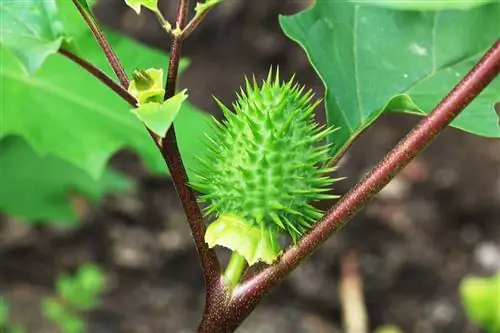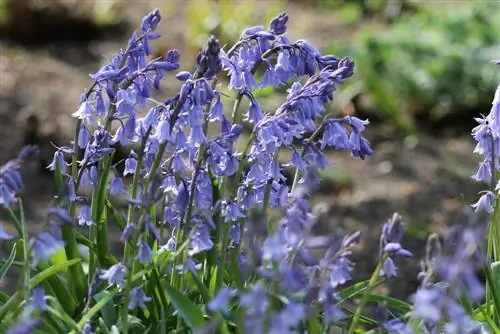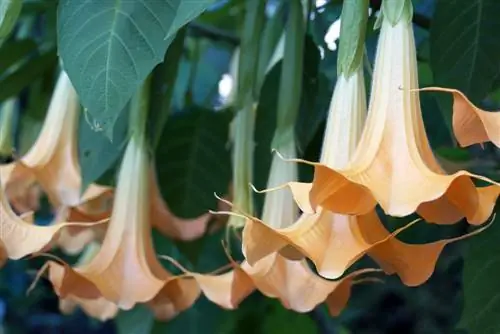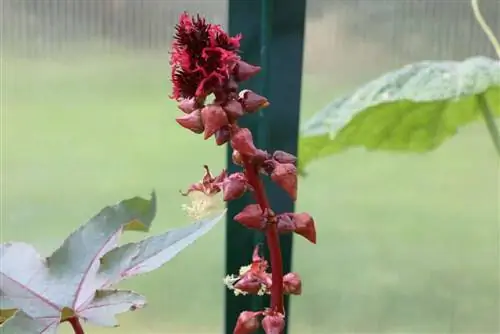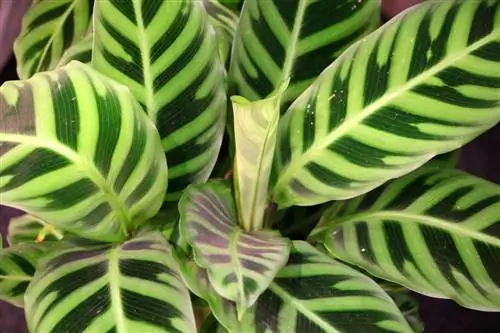- Author admin [email protected].
- Public 2023-12-17 03:39.
- Last modified 2025-01-24 12:45.
With its picturesque blooms, the Deutzia gives the spring garden a special shine in May and June. The close relative of the hydrangeas impresses with its loose, upright or elegantly overhanging habit and furious flower magic in bright white and delicate pink tones. Our hand-picked variety list invites you on a journey of discovery to your most beautiful May flower bush. Once you have found your favorite, the care instructions provide practical advice on how to professionally water, fertilize, cut and overwinter your Deutzie. Well-founded information about toxicity leaves no room for doubt.
Variety list
The botanical relationship with hydrangeas does not prevent Deutzia from gifting us with an individual variety of species and varieties that are only remotely reminiscent of the classic. Competent breeders invested all their skills in crossing the most beautiful species with each other in such a way that their outstanding attributes were combined in magnificent hybrids. The following list of varieties introduces you to hand-picked treasures among the Deutzien in more detail.
High Deutzia (Deutzia magnifica)
This premium variety stretches majestically upwards yet maintains a slender shape with a dense dress of lanceolate, serrate leaves. During the flowering period, the branches with 10 cm long, bright white flower panicles bend casually and elegantly without the bush falling apart. This growth behavior offers several options for integrating the Deutzia into the garden image. The application scenario extends from solitary beds and pots to picturesque flower hedges.
- Growth height: 200 to 300 cm
- Growth width: 150 to 200 cm
Rosendeutzia ‘Mont Rose’ (Deutzia hybrida)
If you are looking for a medium-high flowering shrub, you are well advised to go with 'Mont Rose'. The cup-shaped, pink flowers gradually brighten and end their floral appearance in pure white. The yellow stamens form a striking contrast to the play of colors of the flowers. This variety is perfect as a solitaire in a small garden or as a protagonist on the balcony.
- Growth height: 150 to 200 cm
- Growth width: 100 to 150 cm
Stuffed Deutzia 'Plena' (Deutzia scabra)
The secret queen among the Deutzia varieties boasts lush, double flowers that gather to form 12 cm long panicles. White on the inside and pink on the outside, a romantic play of colors unfolds from May to June, which not only creates moments of floral happiness in country houses and farm gardens. However, there should be enough space available for the flower beauty, because it doesn't believe in minimalist restraint. The clump-like arrangement of its basic shoots gives this high-quality variety - despite its loose, slightly overhanging growth - the potential to become an opaque flower hedge.
- Growth height: 250 to 350 cm
- Growth width: 180 to 250 cm
Strawberry scented Deutzia 'Strawberry Field' (Deutzia hybrida)
Anyone who wants a Deutzia with strong colors will take note of this variety with interest. 'Strawberry Field' enchants with dark purple-red cup flowers that shimmer pink towards the inside. The arrangement of the flowers is typical of this hybrid. Instead of forming long panicles, they form into cone-shaped groups above the bluish-green foliage. On warm spring days, the flowers exude a delicate scent of strawberries, which attracts hordes of butterflies. Since this Deutzia maintains its tightly upright growth, it thrives in less space than its counterparts.
- Growth height: 100 to 150 cm
- Growth width: 80 to 140 cm
Rosendeutzia 'Tourbillon Rouge' (Deutzia magnifica)
The novelty within the variety family is the result of a targeted improvement in the winter hardiness of Deutzien. This does not mean that optimized frost tolerance comes at the expense of flower beauty. On the contrary, the Deutzia 'Tourbillon Rouge' with dark pink flowers edged in white advocates giving it a prominent place in the sun in the bed and pot. However, the Deutzia has no objection to being combined with other flowering shrubs, such as noble lilac, weigela, viburnum or farmer's jasmine to form a furious hedge.
- Growth height: 200 to 300 cm
- Growth width: 200 to 250 cm
‘Rosealind’ (Deutzia elegantissima)
If you are still looking for the ideal companion for the spring-fresh balcony or the cozy seating area in the garden, we would like to recommend 'Rosealind' to you. Without taking up much space, it spreads its colorful floral flair with carmine-red cupped flowers on tightly upright shoots. The elegant floral pattern is accentuated by narrow leaves in light green.
- Growth height: 100 to 150 cm
- Growth width: 60 to 100 cm
Low Deutzia (Deutzia rosea)
A small-growing Deutzia should not be missing from a balanced list of varieties, so that you don't have to miss out on the atmospheric symphony of flowers when space is limited. The compact variety usually stays under 100 cm and grows as wide as it is tall. From June to July, countless star blossoms appear in the sunny location, which are white on the inside and pink on the outside, complemented by yellow stamens. Dark green foliage rounds off the decorative appearance.
- Growth height: 80 to 100 cm
- Growth width: 60 to 80 cm
Care instructions

Labeling Mayflower bushes as easy to care for can lead to people neglecting important aspects of cultivation. Given the rapid growth of up to 50 cm per year and the winter hardiness that is not always unconditional, the amount of care required should not be underestimated. As the following instructions show, the relevant measures can still be mastered easily even by beginners.
Location
The botanical relationship with hydrangeas does not imply that the same location conditions apply to the deutzia. On the contrary, the flowering shrub is a sun worshiper. Therefore, assign the rose deutzia a location with these basic conditions:
- Sunny to shady location
- Part shade reduces the abundance of flowers
- Warm and protected from the wind
While summer heat only increases water consumption, a spot in a cold draft can cause the flowers and leaves to trickle down. This applies equally to a location in the bed and on the balcony. The more protected the location, the better the Deutzia, which comes from Asia, survives a Central European winter.
Soil and substrate
The Deutzia thrives in any good garden soil that is rich in nutrients and fresh and moist. The soil should be loose, humus-rich and permeable so that the water drains off quickly even after a heavy rain shower. If the quality of the soil does not meet the criteria, simply compensate for deficiencies with additives. Clay-based, firm soil is loosened with sand and fine grit. You can optimize sandy-dry soil with compost, leaf mold or bark humus.
Deutzians thrive as heartroots with a richly branched system of fine roots. In the pot, a structurally stable compost-based potting soil meets the requirements of the root ball very well. Additives such as perlite, lava granules or expanded clay provide the necessary permeability. The best choice is a high-quality potting soil in which peat has been replaced with coconut or wood fiber.
Plants in the bed
The best time to plant all Deutzia in the bed is in autumn. Although trees grown in containers are allowed to be in the ground throughout the entire growing season, the sun-warmed soil in September and October offers the plants ideal starting conditions. How to plant your rose deutzia correctly:
- Soak the potted root ball with water
- Dig a planting pit with twice the circumference of the root ball
- Shove the excavation into a wheelbarrow to enrich it with compost and horn shavings
- Unpot the Deutzia, position it in the middle of the hole and fill with soil
The root disc should end up just below the soil surface. Press the soil well and water with normal water. When associated with other shrubs, the ideal planting distance is half the expected height.
Plants in pots
To cultivate a starlet bush in a pot, we recommend spring as the planting time, when night frosts are no longer expected. Please choose a large pot with a depth of at least 30 cm. There should be 2 to 3 finger widths of space between the root ball and the edge of the container. Please leave a bucket without a bottom opening aside, as waterlogging is inevitable here. The planting procedure is similar to that in the bed. Additionally, spread drainage in the ground over the water drain. Clay shards, grit, pebbles or similar inorganic materials are suitable for this purpose.
Then place the pot in a partially shaded location for 8 to 10 days to acclimatize. If the young leaves of a Deutzia are suddenly placed in full sun, leaf damage can occur. These appear in the form of light brown spots with a dark border and do not heal again.
Tip:
Buckets in light colors prevent the soil from heating up so much in full sun that the roots stop working. Not using a coaster effectively prevents harmful waterlogging in rainy weather. Instead, adjustable feet promote ventilation of the root ball from below and allow excess irrigation water to drain away unhindered.
Pouring
The water requirement is at a high level, especially during the flowering period. Even soil moisture ensures that your Deutzia does not suffer from drought stress and drop its flowers. You can specifically avoid harmful waterlogging by allowing the substrate to dry between waterings. Please note that you need to water the pot more often than the bed.
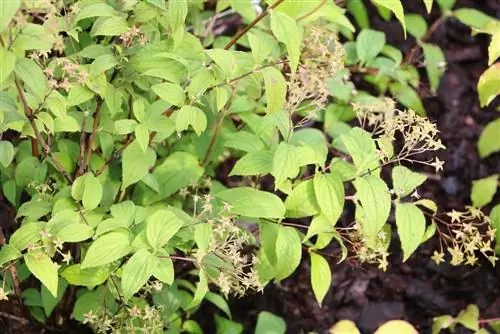
Since the ornamental tree sheds its leaves in autumn, the water requirement in winter is reduced to a minimum. Only water the bed and container when necessary so that the root ball does not dry out. This is particularly true under the influence of cold frost, when there is no snow or rain when the sun is shining.
Fertilize
Modesty is what sets the star bush apart when it comes to its nutrient requirements. In good garden soil, starting fertilization with compost and horn shavings in October or with mineral-organic fertilizer in March is sufficient. Since organic fertilizer must first be broken down by soil organisms until it is available for the roots, it is administered in the fall. Apply a fertilizer superficially to the root disc and then water again.
For Deutzia in the pot, we recommend giving liquid fertilizer for flowering plants every 4 weeks from March to June. Alternatively, administer fertilizer sticks with a long-term effect once in March, which are simply pressed into the substrate.
Cutting
Since the Mayflower bush grows in size quite quickly, it receives regular shape and maintenance pruning. The best time for this care is after the end of the flowering period, as Deutzias produce the buds for the next season in the same year. If pruning takes place in late winter, numerous buds will fall victim to it. This cut has proven successful on the star bush:
- The best date is an overcast, not too hot day in July
- Short shoots that are too long by a maximum of half
- Always cut just above a pair of leaves
- Clean out all wilted flowers to prevent seed heads from forming
During the leaf-free period, late winter is a good opportunity to protect a rose deutzia from becoming bald by thoroughly thinning it out. By cutting off all dead wood at the base, enough light reaches all vital branches so that leaves can sprout again. This measure also includes the removal of branches that are too close together. You should at least thin out the weaker shoots. If inward-facing branches interfere with uniform growth, cutting close to the ground will solve the problem.
Tip:
Continuous rejuvenation is more tolerable than radical pruning. Experienced Deutzian gardeners therefore remove two to three of the oldest shoots close to the ground at two-year intervals from the third year onwards.
Wintering
Deutzians are generally assigned to winter hardiness zone Z5. This means that temperatures of -23.4 to -28.8 degrees Celsius do not cause any problems. This classification has only limited relevance for highly bred noble hybrids on this variety list. Although there are no well-founded scientific studies on this, it can be assumed that winter hardiness is weaker in the Z6 range. Specifically, this means between -17.4 and -23.4 degrees Celsius for well-rooted, adult Deutzia. To avoid any risk of failure, we recommend the following precautions:
- In the year of planting, provide every Mayflower bush with winter protection
- Cover the root slice with leaves and brushwood
- After the leaves have fallen, cover the branches with breathable fleece
- Place the bucket on a block of wood in front of the south wall of the house
- Cover the container with several layers of bubble wrap
- Water a little in the bed and pot on frost-free days
In regions with harsh winters, repeat these measures during the first 2 to 3 years of growth. It is only when you are older that your star bush has developed reliable winter hardiness. However, this does not apply to potted plants. Since the root ball is not protected by the garden soil, a pot should be equipped with a winter coat every year.
Propagate
In conjunction with the shape and maintenance pruning, the cuttings produce suitable material for vegetative propagation. Both head shoots and one- to two-year-old middle sections of a branch are suitable for cutting. In both cases, the cuttings should not bear any flowers and should be he althy. Make the cut below a leaf node or pair of leaves. Pluck off the lower part of the leaves and dip the cut area in rooting powder. Proceed as follows:
- Fill a growing pot for each cutting with coconut fiber substrate or peat sand
- Drill the planting hole with a pricking stick to pot the offshoot two thirds of its length
- Press the substrate well and water
Take care of the cuttings in a partially shaded, warm location until autumn. You can plant a strong young plant in the bed as early as September/October. If in doubt, overwinter the young Deutzia in a bright window seat at temperatures around 15 degrees Celsius. A slightly temperate winter garden, a bright bedroom or a garage with windows are well suited. By next spring, the hesitant offshoots will have transformed into a vital young plant and can be planted out.
Toxicity information
The Deutzia genus belongs to the hydrangea family and therefore to the dogwood order. This botanical classification may raise doubts about its safety, as some dogwoods are considered slightly poisonous. In view of the distant relatives, the all-clear can be given at this point. May flower bushes are not poisonous and are therefore suitable for the family garden. However, it is not advisable to consume the leaves, flowers and fruits in large quantities. Please do not use the clippings or leaves as green food for pets.
Conclusion
There should always be a place reserved in creative garden design for the picturesque flower symphony of a Deutzia. In all sunny locations with good garden soil, the star bush enchants us from May to June with fragrant, white, pink or crimson flowers that gather in long panicles or furious groups. As this list of varieties shows, there is the right Mayflower bush for everyone, from large parks to small gardens and balconies. The focus in care is on the high water requirement during the flowering period. In the first few years, light winter protection protects young Deutzia from severe frost. Thanks to the good-natured pruning tolerance, shape and size can be easily regulated after the flowering period.


